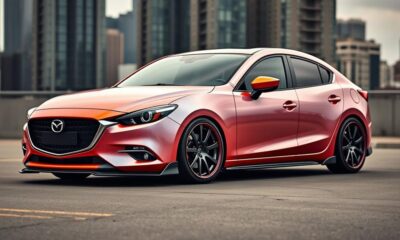Kia Tuning
Kia Optima 2018 Tuning: Transforming Your Sedan Into a Performance Powerhouse
With the right tuning and modifications, your 2018 Kia Optima can unleash incredible power—discover how to elevate your sedan’s performance today!

You can easily transform your 2018 Kia Optima into a performance powerhouse with effective tuning and modifications. Start by considering the KSR tune, which boosts your 2.4L engine to about 310 wheel horsepower for a reasonable price. Pair it with aftermarket parts like the K&N Typhoon intake and a front-mounted intercooler to enhance performance even further. Don't forget to use high-quality fuel, ideally 93 octane, to maximize your gains. Regular tuning and maintenance are also key for reliability. Keep exploring the options, and you'll find even more ways to upgrade your driving experience.
Key Takeaways
- The 2018 Kia Optima's 2.4L engine can be tuned for improved performance with a cost-effective KSR tune, boosting it to approximately 310 wheel horsepower.
- Pairing the KSR tune with aftermarket parts like a K&N Typhoon intake and a CX Racing intercooler enhances performance significantly.
- Methanol injection kits can further elevate power output to 330-345 wheel horsepower, maximizing the engine's potential.
- Using high-quality 93 octane fuel is essential for optimal performance and effective tuning of the Kia Optima.
- Regular maintenance and moderate driving habits are crucial to ensure engine reliability and prevent strain during performance enhancements.
Engine Potential and Modifications
When it comes to the Kia Optima 2018, the engine potential, particularly with the 2.4L GDI engine, presents some challenges for tuning enthusiasts.
While you might be tempted to immerse yourself in performance modifications, the aftermarket options are quite limited. Upgrading to an intake from the LX 2.4 model can enhance your throttle response and sound, but you'll likely find that significant power increases are rare without a hefty investment.
The 2.4L Theta II engine can only safely support a boost of 5-7 psi, which pales in comparison to the 2.0L engine's 24 psi capability. This limitation underscores the tuning potential constraints of your vehicle.
While you can make some modifications, the returns mightn't justify the effort. It's also essential to maintain engine health through regular oil changes and by avoiding aggressive driving habits, especially if you're considering any performance modifications.
Ultimately, many enthusiasts find themselves seeking alternatives with greater tuning potential, as the inherent limitations of the 2.4L engine can be disappointing.
Focus on maintaining your vehicle first, and weigh your options carefully before engaging in modifications.
Driving Modes and Fuel Efficiency
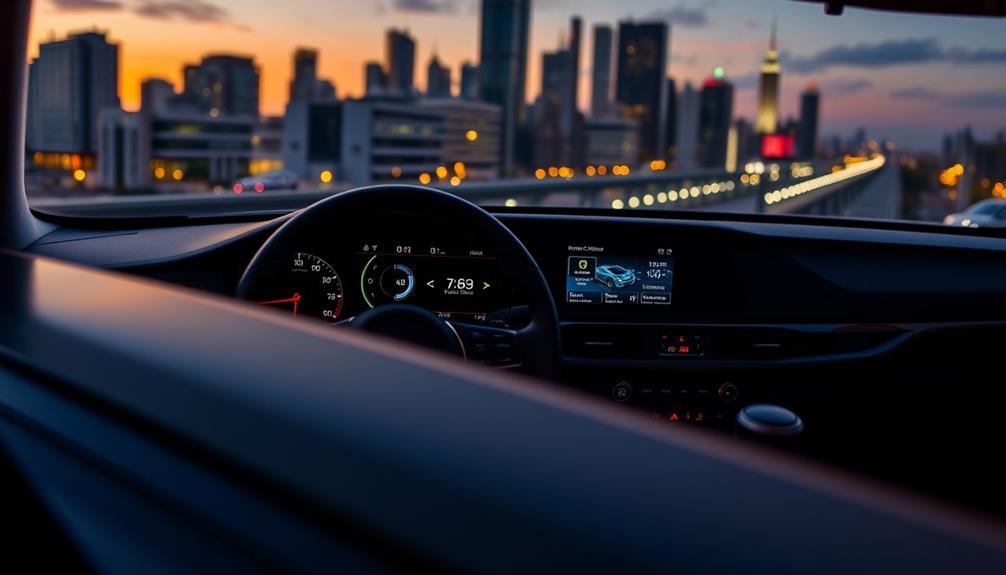
The Kia Optima's driving modes greatly influence both performance and fuel efficiency. Engaging Sport Mode enhances engine responsiveness, providing you with a dynamic driving experience. However, this comes with increased fuel consumption and potential risks.
To maintain a balance, consider these key points:
- Continuous use of Sport Mode can lead to engine failure, especially in turbocharged variants.
- Aggressive driving in Sport Mode compromises engine longevity.
- Manual shifting allows you to optimize performance while managing fuel economy.
- Maintaining moderate driving styles improves overall fuel efficiency.
- The 2.4L engine's performance constraints limit significant gains from aggressive driving.
Performance Limitations
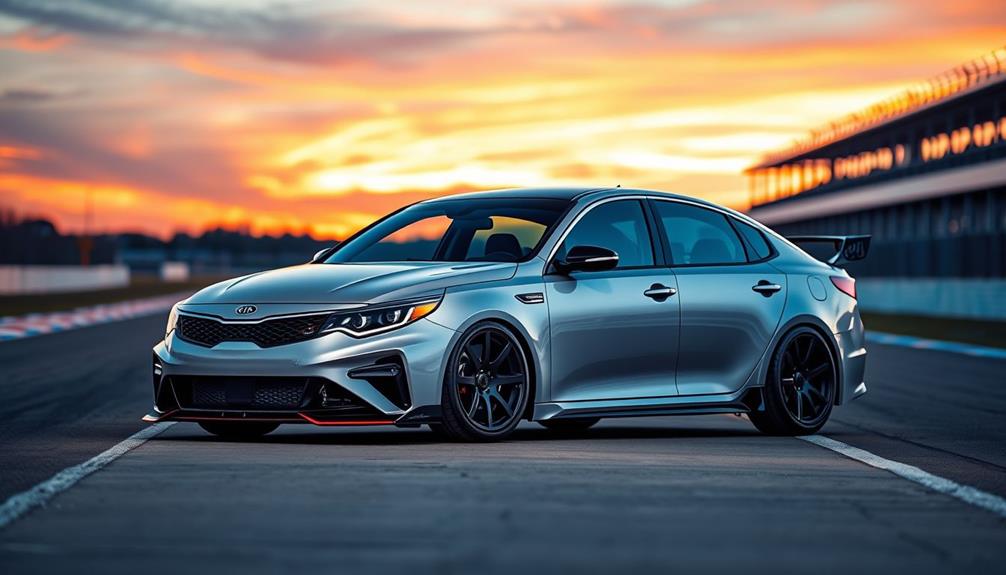
Although many enthusiasts seek to enhance the performance of the Kia Optima, the 2.4L engine presents notable limitations that make significant power increases challenging. This engine's design inherently restricts modifications, as it typically yields only minor improvements in throttle response and sound rather than substantial horsepower gains.
While you might be tempted to invest in performance upgrades, the reality is that the 2.4L engine isn't built to handle the same boost levels as its turbocharged counterparts.
For instance, the 2.0L engine from the same era can support up to 24 psi boost, highlighting the 2.4L's performance limitations. Reports indicate that the 2.4L Theta II engine safely supports only 5-7 psi boost, which further emphasizes its constraints.
Given these limitations, many users find that any performance modifications they undertake often fall short of expectations, resulting in an underwhelming return on investment.
Thus, if you're set on boosting your Kia Optima's performance, you might want to reconsider your options or look into alternative engines that offer more potential for significant upgrades.
Comparisons With Other Engines

When you compare the Kia Optima's 2.4L engine to the more powerful 2.0L turbocharged alternatives, the performance potential becomes clear.
The turbocharged engines not only offer higher boost levels but also deliver substantial horsepower gains that the naturally aspirated 2.4L simply can't match.
This limitation makes it evident that if you're looking for serious performance upgrades, exploring turbocharged options is the way to go.
Performance Potential Overview
Many enthusiasts find the performance potential of the 2018 Kia Optima's engines to be a mixed bag, especially when comparing the 2.4L Theta II engine to its 2.0L turbocharged counterpart.
While the 2.4L engine's performance upgrades can offer some improvement, the gains are often underwhelming.
- The 2.4L engine has limited performance potential, supporting only 5-7 psi of boost.
- In contrast, the 2.0L turbocharged engine handles up to 24 psi, leading to significant horsepower gains.
- Users have reported that modification opportunities for the turbocharged engine yield much better results.
- Many consider the cost-to-benefit ratio of upgrading the 2.4L engine unfavorable.
- Enthusiasts often suggest exploring other vehicles for better turbocharged options.
In essence, if you're looking for substantial horsepower gains and effective performance upgrades, the 2.4L engine mightn't be your best bet.
The investment required for decent modifications often doesn't translate into meaningful performance enhancements.
If you're serious about transforming your sedan into a performance powerhouse, you might want to focus your attention on the turbocharged variant instead.
Turbocharged Engine Advantages
The turbocharged 2.0L engine in the 2018 Kia Optima stands out for its impressive performance capabilities, especially when compared to other engines in its class.
Unlike the naturally aspirated 2.4L engine, which limits boost to just 5-7 psi, the turbocharged engine can handle up to 24 psi. This means you can expect significant horsepower gains that make tuning and performance modifications much more rewarding.
When you explore performance upgrades, you'll notice that turbocharged engines generally provide better throttle response and overall driving dynamics.
This translates to a more engaging driving experience, allowing you to enjoy every moment behind the wheel. The potential for noticeable power increases and efficiency improvements with turbocharged variants is far superior to the negligible gains seen with similar modifications on the 2.4L engine.
Investing in a turbocharged engine not only enhances your vehicle's performance but also opens up a world of tuning possibilities.
With the right adjustments, you can transform your Optima into a true performance powerhouse, making every drive an exhilarating adventure.
Embrace the advantages of a turbocharged engine and elevate your driving experience today!
Maintenance and Reliability
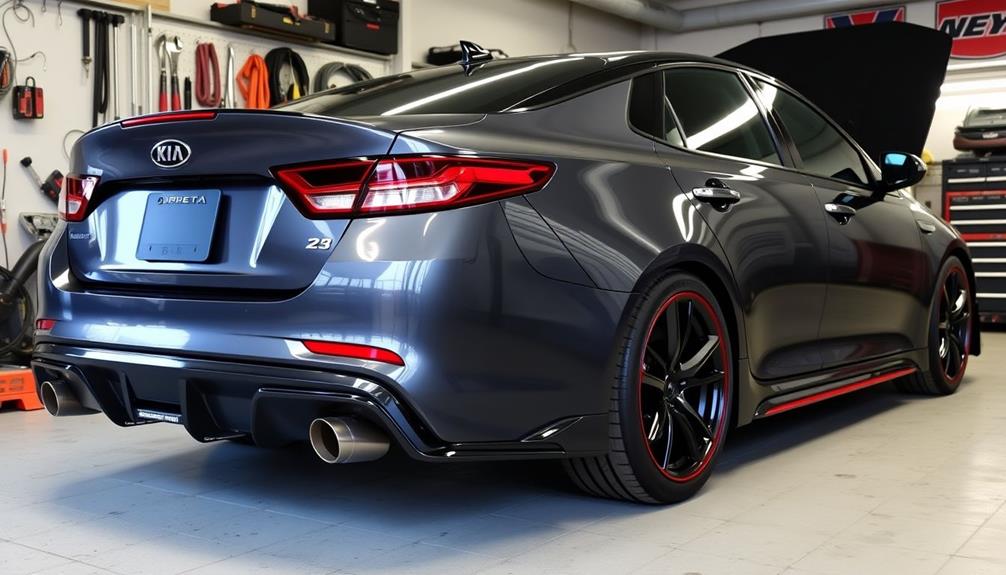
For the Kia Optima 2018, regular maintenance is key to ensuring reliability and ideal performance. By taking proactive steps, you can safeguard your engine's longevity and keep it running smoothly.
It's important to be mindful of your driving habits, as aggressive driving can strain your engine and impact its performance reliability.
To maintain your Kia Optima's engine health, consider these practices:
- Schedule regular oil changes to keep the 2.4L engine running efficiently.
- Monitor oil quality to detect any issues before they escalate.
- Avoid aggressive driving habits that can push your engine beyond its performance limits.
- Utilize manual transmission mode for better control and responsiveness.
- Address unusual noises or performance changes immediately to prevent further damage.
KSR Tune Overview
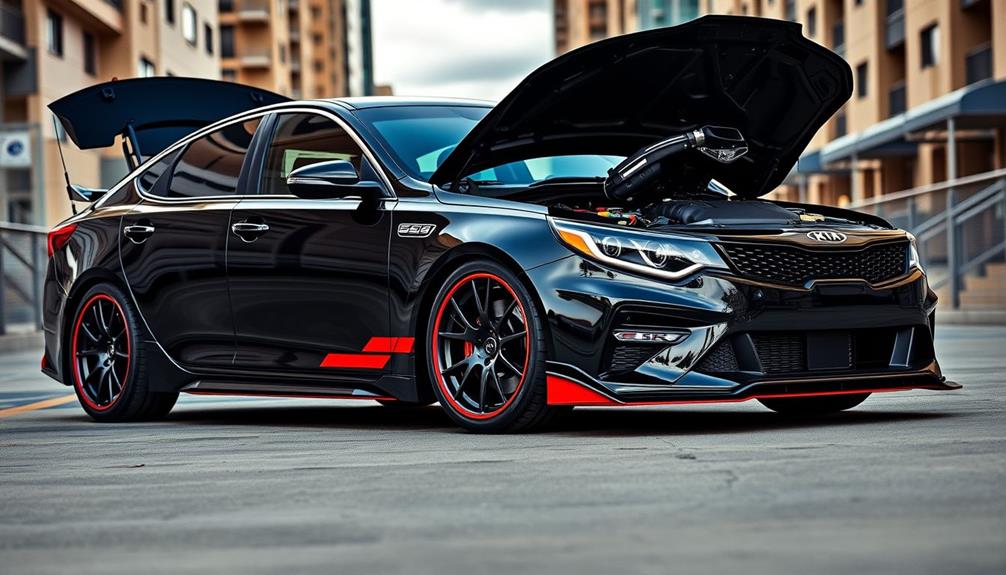
Regularly exploring tuning options can greatly enhance your Kia Optima 2018's performance, and the KSR tune stands out as a top choice. Priced at just $600, it offers an impressive boost to approximately 310 wheel horsepower, making it a cost-effective solution compared to competitors who charge around $1,200 for similar gains of 40-50 wheel horsepower.
If you're looking for that extra flair, you can add a pop and gurgle tune for just $50 more.
One of the standout features of the KSR tune is its ability to release brake boost capability, along with adjusting the rev limiter beyond factory settings. By utilizing 93 octane fuel, you'll experience enhanced boost response and an optimized air-fuel ratio.
Additionally, if you're keen on pushing the limits further, incorporating a methanol injection kit can elevate your output to between 330-345 wheel horsepower, while maintaining torque around 310-305.
The KSR tune not only transforms your sedan into a performance powerhouse but also provides a unique blend of power and efficiency that's hard to beat.
Engine Modifications and Enhancements
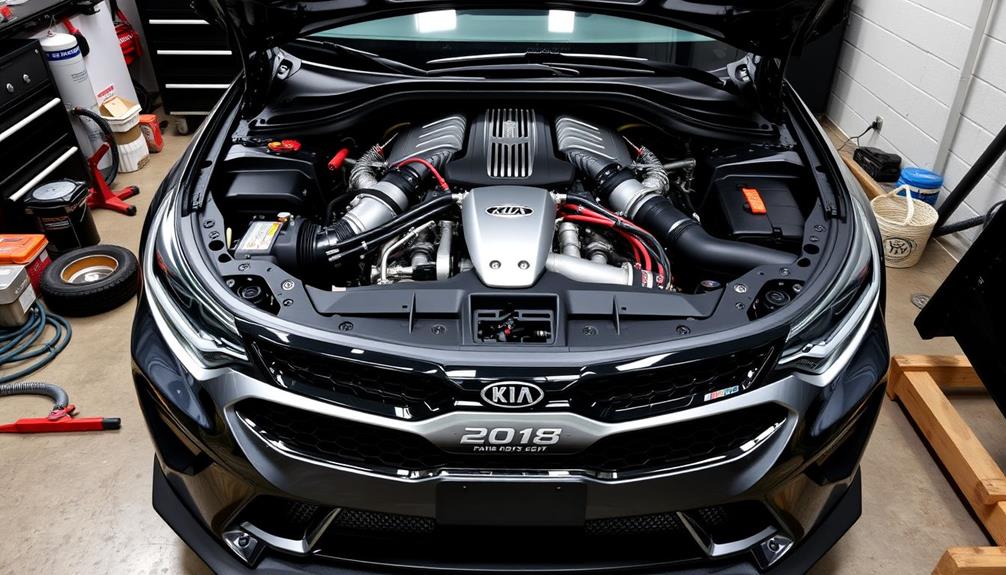
When you're looking to boost your Kia Optima's performance, aftermarket parts and tuning options are key.
Upgrading components like the intake system and intercooler can make a noticeable difference, especially when paired with high-quality fuel.
Let's explore how these enhancements can transform your driving experience.
Aftermarket Performance Parts
A variety of aftermarket performance parts can greatly enhance the driving experience of your 2018 Kia Optima, especially when targeting engine modifications.
By implementing the right upgrades, you can transform your sedan into a performance powerhouse. Here are some modifications to take into account:
- K&N Typhoon intake system: Priced at $350, it improves throttle response and engine sound.
- KSR Performance big turbo kit: This can considerably boost your engine's power output.
- CX Racing front-mounted intercooler: Essential for managing increased boost levels.
- Custom exhaust system: Enhances airflow, resulting in an aggressive engine sound.
- Performance tuning with 93 octane fuel: Maximizes boost response and improves the air-fuel ratio (AFR).
With a big turbo kit, you could see potential horsepower reaching up to 330-345 when combined with methanol injection.
Remember, regular maintenance is key to keeping your engine healthy after these aftermarket modifications.
Avoid aggressive driving to guarantee longevity and reliability.
Engage with the community to gather feedback and shared experiences for effective upgrades, making your tuning journey even more rewarding!
Tuning Options Explained
Exploring tuning options for your 2018 Kia Optima opens up a world of possibilities for engine modifications and enhancements that can greatly elevate performance.
One of the best starting points is the KSR tune, which can boost your car to approximately 310 wheel horsepower for just $600. If you want a little extra flair, you can add the pop and gurgle feature for only $50.
Pairing the KSR tune with a K&N Typhoon intake system, priced at $350, will further enhance airflow and performance.
For even greater gains, consider a methanol injection kit, which can push your output to between 330-345 wheel horsepower while stabilizing torque at 310-305. Peak performance tuning is achieved using 93 octane fuel, enhancing both boost and throttle response.
Don't forget about additional components like an oil catch can and oil cooler, which can help maintain engine health and support your performance enhancements.
With these modifications, you'll transform your Kia Optima into a true performance powerhouse, ready to tackle the road with confidence.
Fuel Quality Impact
Fuel quality plays an essential role in maximizing your 2018 Kia Optima's performance after modifications. To truly elevate your driving experience, consider using high-quality fuel, specifically 93 octane. This choice considerably enhances boost and throttle response while improving the air-fuel ratio (AFR) for better efficiency.
Here's how fuel quality impacts your performance tuning:
- 93 octane provides peak engine performance.
- Methanol injection can elevate performance levels, pushing output to 330-345 wheel horsepower.
- Mixing 91 octane with E85 helps maintain performance in lower octane areas.
- Refueling when 30 miles remain prevents fuel starvation issues.
- Consistent use of high-quality fuel guarantees effective performance tuning.
Fuel Management and Tuning

Ideal fuel management and tuning can dramatically enhance your 2018 Kia Optima's performance. By utilizing 93 octane fuel, you can improve boost response and achieve a better air-fuel ratio (AFR), leading to enhanced efficiency.
Keeping an eye on your fuel level is vital; refueling when you have 30 miles remaining helps maintain consistent fuel quality and prevents any fuel starvation issues that could impact performance.
The tuning process is key to accessing your engine's full potential. You can raise the rev limiter, allowing for higher RPMs and increased horsepower output, while also adjusting the torque limiter for peak performance.
With proper tuning, your Optima can reach an impressive 330-345 wheel horsepower, paired with stable torque around 310-305.
Incorporating methanol injection during tuning can take your performance even further, providing significant horsepower boosts without sacrificing torque.
Regular performance tuning not only enhances throttle response but also improves overall engine efficiency, making it essential for transforming your sedan into a true performance powerhouse.
With the right approach to fuel management and tuning, your Kia Optima will deliver the power and efficiency you've always desired.
Community Engagement and Feedback
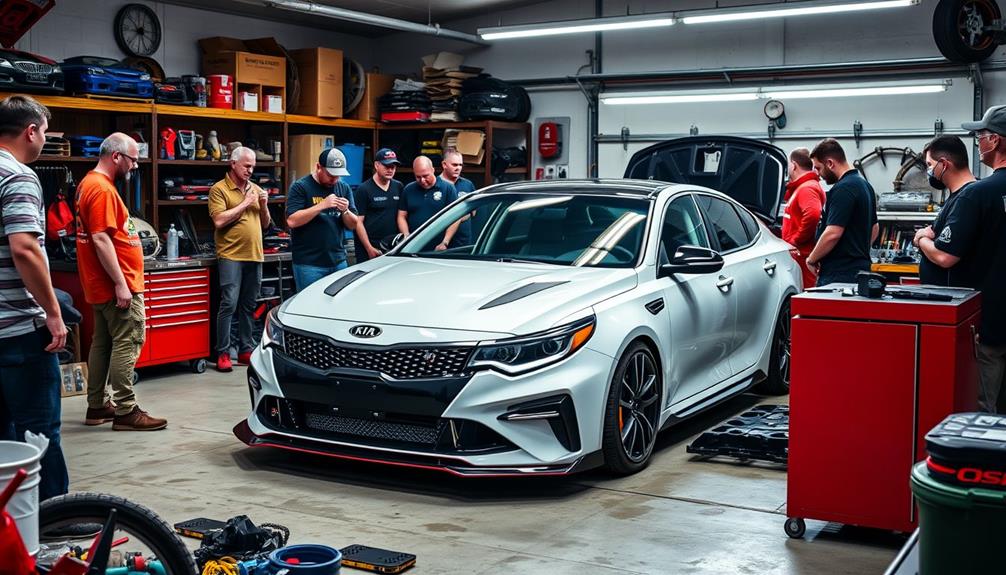
The Kia Optima community thrives on shared experiences and insights, making it a valuable resource for enthusiasts looking to enhance their vehicles.
Community engagement is at the heart of this network, as members actively seek and share feedback on various performance upgrades. By fostering a collaborative environment, you can learn from the successes and challenges of fellow Kia Optima owners.
Here are five ways you can engage with the tuning community:
- Request suggestions for transmission upgrades to spark discussions.
- Share your own modifications and experiences with the group.
- Watch detailed videos on performance upgrades for deeper understanding.
- Participate in engagement initiatives like giveaways and promotions.
- Provide feedback on others' modifications to help refine their setups.
Frequently Asked Questions
Can You Modify a Kia Optima?
Yes, you can modify a Kia Optima. While options are limited, upgrades like a KSR tune, intake systems, and exhausts can enhance performance. Just remember to engage with the community for the best advice and recommendations.
How Much Is a Tune up for a 2018 Kia Optima?
A tune-up for your 2018 Kia Optima typically costs between $100 and $300, depending on services. If you're considering performance upgrades, expect to spend considerably more, often starting around $600 for enhanced tuning options.
How Do You Turn the Bass up on a Kia Optima?
To turn the bass up in your Kia Optima, navigate to the "Sound" menu, slide the bass level higher, and if available, activate any bass enhancement features. Your music will boom like thunder!
How Many Miles Does a 2018 Kia Optima Last?
A 2018 Kia Optima can last between 150,000 to 200,000 miles with proper maintenance. By sticking to regular oil changes and driving conservatively, you might even push it past 200,000 miles.
Conclusion
In summary, tuning your 2018 Kia Optima can really release its hidden potential, transforming it into a performance powerhouse. Did you know that with the right modifications, some owners have reported gains of up to 30% in horsepower? That's a game-changer for any sedan! Engaging in the tuning community not only enhances your ride but also connects you with fellow enthusiasts who share your passion. So, gear up and take your driving experience to the next level! If you are considering tuning your Kia Cerato 2019, you can expect similar impressive results. With the right modifications, you can unlock its full potential and experience a significant increase in power and performance. So, don’t hesitate to explore the possibilities of tuning and elevate your driving experience to new heights with your Kia Cerato 2019!
Ethan is at the forefront of hybrid vehicle technology, making him an invaluable resource for our readers interested in hybrid tuning. His expertise in electric motor upgrades, battery systems, and regenerative braking allows him to provide cutting-edge advice on optimizing hybrid vehicles for performance and efficiency. Ethan’s work ensures that our content stays ahead of the curve in the rapidly evolving world of hybrid technology.
Kia Tuning
Kia Sorento Tuning 2021: Transforming Your SUV Into a Performance Powerhouse
Discover how tuning your 2021 Kia Sorento can unleash its hidden power and transform your driving experience into something extraordinary. Are you ready to find out how?
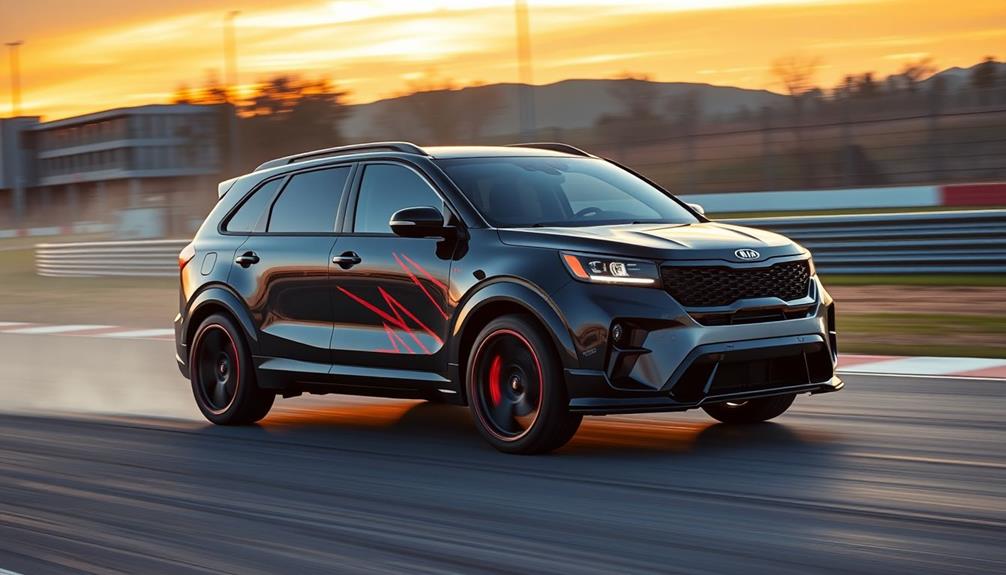
Tuning your 2021 Kia Sorento can elevate its performance from a solid SUV to a high-powered machine. Start by considering performance chip modules or ECU remapping to enhance horsepower and throttle response. Upgrading the exhaust system can improve airflow, while enhancing the suspension will boost handling. Don't forget about braking; high-performance pads and larger rotors can guarantee you stop as well as you go. Balancing power upgrades with safety is key, so professional installation is vital. Explore these options further to truly transform your Sorento and release its full performance potential.
Key Takeaways
- Performance Chip Modules like Burger Motorsports JB4 can enhance your Kia Sorento's horsepower and acceleration by optimizing ECU signals.
- ECU Remapping recalibrates fuel injection for improved throttle response and can activate features not available in factory settings.
- Upgrading your exhaust system enhances exhaust flow, potentially boosting horsepower, torque, and fuel efficiency.
- Suspension and handling improvements through upgraded shock absorbers and sway bars enhance traction and body control during sharp turns.
- Investing in high-performance brake systems ensures improved stopping power and safety, especially beneficial for aggressive driving or towing.
Performance Chip Modules
When you're looking to boost your Kia Sorento's performance, performance chip modules can be an appealing option. These devices, including OBD2 plug-and-play units, claim to enhance horsepower, leading to improved acceleration and overall driving performance. They work by sending enriched signals to your engine control unit (ECU), which may help optimize your vehicle's capabilities.
However, the effectiveness of these performance chip modules can vary. Some drivers report noticeable improvements, while others experience minimal or no changes at all. This inconsistency often arises because the ECU might compensate for the chip's adjustments, limiting the potential benefits.
If you want to maximize the gains you get from these modules, consider investing in ECU tuning instead. Professional tuning provides a level of customization and control that plug-in chips typically can't match.
Additionally, it's wise to research reliable brands before making a purchase. Some options even allow for ECU tuning, which can enhance fuel economy while boosting performance.
Enhancing Engine Power

To enhance the engine power of your 2021 Kia Sorento, consider a combination of tuning options that can unleash its full potential. The Sorento comes equipped with a robust 2.5L turbocharged I4 engine, generating 281 hp and 311 lb-ft of torque. This foundation is perfect for performance tuning.
One popular choice is the Burger Motorsports JB4, a performance chip that maximizes horsepower while allowing easy removal if needed. People know that plug-and-play performance chips can improve engine power by sending enriched signals to the ECU, but be aware that results can vary.
It's crucial to assess their effectiveness professionally. Additionally, optimizing fuel trim data can help you monitor performance changes, ensuring your modifications don't negatively impact fuel efficiency.
While many performance chips boast significant horsepower gains, traditional modifications like exhaust upgrades often provide clearer benefits. By focusing on these options, you can unlock your Kia Sorento's full performance potential, making it a true powerhouse on the road.
Improving Suspension and Handling

To boost your Kia Sorento's suspension and handling, consider upgrading your shock absorbers for better damping control and a smoother ride.
Adding sway bars can enhance stiffness, giving you improved traction during sharp turns.
Lowering springs can also lower your center of gravity, leading to better aerodynamics and handling performance.
Upgraded Shock Absorbers Benefits
Upgraded shock absorbers can transform the driving experience of your Kia Sorento, greatly enhancing its suspension performance. By investing in high-quality shocks, you'll notice improved stability and control, especially during cornering and on uneven surfaces. This enhancement reduces body roll, making your Sorento more responsive during aggressive maneuvers.
Many aftermarket shock absorber kits are compatible with your existing suspension setup, so you won't need extensive modifications. Performance shocks also excel at absorbing road imperfections, leading to a smoother ride for you and your passengers. If you enjoy customizing your driving experience, some upgraded shocks come with adjustable settings, allowing you to switch between sporty handling and comfort.
Here's a quick overview of the benefits:
| Benefit | Description | Impact on Driving Experience |
|---|---|---|
| Improved Stability | Enhanced control during cornering | Greater confidence in handling |
| Reduced Body Roll | Less leaning during turns | More responsive maneuvers |
| Compatibility | Works with existing suspension | Easy installation |
| Adjustable Settings | Customize ride stiffness | Tailored comfort or sportiness |
With upgraded shock absorbers, you can elevate your Kia Sorento's performance to new heights!
Sway Bar Enhancements
Sway bar enhancements can make a noticeable difference in your Kia Sorento's handling and overall driving dynamics. By upgrading to a stiffer sway bar, you'll remarkably reduce body roll during cornering, which translates to improved stability and control. This upgrade allows for sharper steering input, making your SUV feel more responsive, especially during aggressive driving maneuvers.
Aftermarket sway bar kits are available, often featuring a larger diameter than the stock option. This increase can further enhance performance by minimizing lateral movement, giving you a more planted feel on the road.
With enhanced sway bars, you'll find that high-speed turns become more confident, and evasive maneuvers feel more controlled.
However, it's essential to recognize that proper installation is vital for maximizing these benefits. Alignment adjustments are typically necessary to guarantee peak performance and tire wear, so consider enlisting a professional for the job.
Lowering Springs Impact
Enhancing your Kia Sorento's performance doesn't stop with sway bar upgrades; lowering springs offer significant benefits as well. By reducing the ride height by about 1 to 2 inches, you lower the center of gravity, which dramatically improves handling stability, especially during cornering.
With a lowered suspension, you'll notice reduced body roll, making the steering more responsive and providing a sportier driving experience.
Additionally, lowering springs can enhance your SUV's aerodynamics. This could lead to a slight increase in fuel efficiency due to reduced drag when you're cruising at higher speeds.
The stiffer suspension setup that comes with lowering springs also contributes to better traction, allowing your tires to maintain better contact with the road during aggressive driving scenarios.
Keep in mind, though, that installing lowering springs may require compatibility adjustments with upgraded shocks to fully optimize performance. This guarantees that you avoid potential issues like bottoming out or excessive wear on suspension components.
Upgrading Exhaust Systems

When it comes to improving your 2021 Kia Sorento's performance, upgrading the exhaust system is a smart choice. By enhancing exhaust flow and reducing back pressure, you can boost horsepower and torque, resulting in a more responsive engine.
Consider investing in a high-performance cat-back exhaust system, which not only increases power but also transforms the sound of your SUV, giving it a sportier exhaust note that many enthusiasts love.
Additionally, a quality exhaust upgrade can improve fuel efficiency. A more efficient system allows your engine to breathe better, potentially leading to better MPG under certain driving conditions. You'll appreciate the dual benefit of performance and savings at the pump.
Many aftermarket exhaust systems are crafted from lightweight materials like stainless steel or aluminum, helping to reduce overall vehicle weight and improve handling. This means you'll enjoy not only enhanced performance but also a more agile driving experience.
Installing an upgraded exhaust system is typically straightforward and can often be done with basic tools, making it an accessible modification for DIY enthusiasts.
Embrace the thrill of transforming your Kia Sorento into a performance powerhouse with an exhaust upgrade!
ECU Remapping Benefits

After upgrading your exhaust system, consider the benefits of ECU remapping to further enhance your 2021 Kia Sorento's performance.
By recalibrating fuel injection, ignition timing, and boost pressure, ECU remapping can optimize your engine's performance, potentially exceeding the stock specifications of 281 hp and 311 lb-ft of torque. You'll likely feel a noticeable improvement in throttle response and acceleration, allowing you to shave seconds off your 0-60 mph time, which is already around 7.5 seconds.
Moreover, effective remapping can lead to better fuel efficiency. By optimizing the air-fuel mixture across various driving conditions, you might enhance your EPA ratings of 24 mpg city and 29 mpg highway.
Additionally, proper ECU tuning can reveal features and performance enhancements that factory settings don't activate, giving you a more customized driving experience.
However, it's vital to consult with professionals who can accurately perform the remapping using diagnostic tools. This guarantees that your ECU remap is safe and maintains your vehicle's reliability and warranty coverage.
With these benefits, remapping your ECU could be a significant step in transforming your Kia Sorento into a true performance powerhouse.
Brake System Enhancements

To boost your 2021 Kia Sorento's performance, evaluating brake system enhancements is vital. Upgrading to high-performance brake pads, like ceramic or semi-metallic options, can greatly improve your stopping power and reduce brake fade during spirited drives.
If you plan on towing or off-roading, installing larger, vented rotors will enhance heat dissipation and increase braking efficiency.
You might also want to think about adding stainless steel brake lines. They provide a firmer pedal feel and improved response by minimizing line expansion under pressure.
Additionally, a brake fluid upgrade to a higher boiling point is important, especially during aggressive driving or high-temperature conditions, as it helps prevent brake fade.
Incorporating a brake booster upgrade will further enhance your pedal feel, reducing the force needed for effective braking. This contributes to overall driving safety and performance, allowing you to navigate various driving scenarios confidently.
With these enhancements, your Sorento won't just be a comfortable ride; it'll also transform into a performance powerhouse that's ready for any challenge on the road.
User Experiences and Feedback

Upgrading your brake system can considerably enhance your driving experience, but user feedback on other modifications, like performance chips, reveals a range of results. Many owners of the 2021 Kia Sorento report mixed experiences with these chips. While some enjoy noticeable horsepower gains, others see little to no change in performance. This inconsistency can be frustrating, especially when you're enthusiastic for improvements.
A key takeaway from user experiences is the importance of ECU tuning capabilities. Enthusiasts stress that proper tuning is vital for maximizing the benefits of any aftermarket modifications. Specific brands, such as Burger Motorsports JB4, stand out for their reliability and effectiveness, earning positive recommendations from users who've experienced tangible performance boosts.
However, it's important to remain cautious. Many users worry that the ECU might adjust to the enriched signals from plug-and-play devices, potentially diminishing the expected gains.
To better navigate these options, users advocate sharing before-and-after performance data within the community. This transparency can help you make more informed decisions about tuning your Kia Sorento and achieving the performance enhancements you desire.
Safety Considerations

When tuning your 2021 Kia Sorento for performance, you've got to strike a balance between power and safety.
Modifications can impact your vehicle's stability and safety features, so it's vital to reflect on how each change affects your overall driving experience.
Professional installation is imperative to guarantee that safety standards are upheld while you enhance your ride's capabilities.
Performance Vs. Safety Balance
Balancing performance enhancements with safety is essential for drivers of the 2021 Kia Sorento. With its impressive 5-star overall safety rating from the NHTSA, you can confidently explore performance upgrades without compromising security. Advanced driver assistance features, like lane keeping assist and blind-spot monitoring, work hand-in-hand with tuning modifications to keep you safe on the road.
Here's a quick overview of important safety features and their benefits:
| Feature | Benefit | Performance Impact |
|---|---|---|
| Lane Keeping Assist | Helps maintain lane discipline | Supports spirited driving |
| Forward Collision Warning | Alerts you of potential hazards | Enhances reaction time |
| Automatic Emergency Braking | Engages brakes in urgent situations | Guarantees control during performance |
| LATCH System for Rear Seats | Secures child safety seats | Don't compromise on family safety |
Impact of Modifications
Modifications to your 2021 Kia Sorento can enhance performance, but they also come with safety considerations that shouldn't be overlooked.
When you upgrade the engine or suspension, it can alter your vehicle's handling dynamics, potentially affecting its response in emergency situations. For instance, performance chips that boost horsepower might increase speed but can compromise stability and extend stopping distances unless you also upgrade the brakes accordingly.
Additionally, aftermarket changes like new exhaust systems can impact emissions and lead to non-compliance with local regulations, which could affect safety inspection outcomes.
Altering your Sorento's tires or suspension setup might change its center of gravity, raising the risk of rollovers during sharp turns or evasive maneuvers.
It's essential to guarantee that any performance upgrades don't interfere with your factory safety systems, such as airbags and stability control.
These systems are critical for keeping you and your passengers safe. Always consider the implications of your modifications on safety features, as maintaining the integrity of these systems is important for your vehicle's overall safety.
Professional Installation Importance
Getting your tuning devices professionally installed is imperative for guaranteeing your modifications integrate seamlessly with your Kia Sorento's ECU. When you opt for expert installation, you minimize the risk of malfunctions and performance issues that can arise from incorrect setups. A professional technician knows how to connect devices correctly, preventing potential battery drain caused by improperly wired components that might continuously draw power.
Moreover, trained technicians can assess your vehicle's performance both before and after tuning, giving you essential information about fuel trim changes and overall effectiveness. This thorough evaluation is critical for achieving the best results from your modifications.
Professional services also conduct diagnostic checks to confirm that any new installations don't interfere with your SUV's existing safety features, helping maintain its 5-star NHTSA safety rating.
Utilizing expert installation can also help you catch potential issues stemming from aftermarket adjustments, protecting your vehicle's warranty and saving you from costly repairs down the line.
In the end, choosing professional installation not only enhances your Kia Sorento's performance but also safeguards its integrity and your investment.
Cost Vs. Value Analysis

When considering performance tuning for your 2021 Kia Sorento, it's vital to weigh the cost against the potential value gained. The investment can vary markedly, from a few hundred dollars for simple plug-and-play chips to several thousand for thorough ECU remapping and hardware upgrades.
To help you navigate this decision, consider these key points:
- Quality vs. Cost: Investing in reliable tuning solutions like the Burger Motorsports JB4 often yields better performance gains compared to cheaper alternatives.
- Measurable Improvements: Traditional modifications, such as exhaust upgrades, typically offer clearer benefits, making it easier to justify their costs.
- Performance Monitoring: Tracking your vehicle's performance data before and after tuning can clarify whether your investment translates to notable horsepower and fuel efficiency gains.
Ultimately, while you might be tempted by low-cost options promising immediate boosts, the actual benefits could be minimal without proper ECU tuning.
Carefully evaluating the cost-to-value ratio is vital to guarantee that your tuning investment enhances your driving experience in a meaningful way.
Frequently Asked Questions
Can You Tune a Kia Sorento?
Yes, you can tune a Kia Sorento. You might use aftermarket performance chips or professional tuning services to boost horsepower and torque, but consider the impacts on warranty and fuel efficiency before making changes.
What Is the Most Common Problem With Kia Sorento 2021?
When you plunge into the 2021 Kia Sorento, the most common issue you'll encounter is electrical problems. Owners report infotainment glitches, dashboard warning lights, and occasional transmission hesitations that can disrupt your driving experience.
Can You Remap a Kia Sorento?
Yes, you can remap a Kia Sorento to enhance its performance. Just make certain you work with a reputable tuner who understands your vehicle's limits and won't compromise its reliability or void your warranty.
What Is the Best Engine for the Kia Sorento?
When it comes to engines, you'll find the turbocharged 2.5L I4 is your best bet. It delivers a thrilling 281 horsepower and 311 lb-ft of torque, transforming your driving experience into something truly exhilarating.
Conclusion
In transforming your 2021 Kia Sorento into a performance powerhouse, you're not just enhancing its capabilities—you're starting on a thrilling journey reminiscent of the legendary muscle cars of yesteryear. By tuning your SUV with performance chips, upgraded exhaust systems, and improved handling, you're crafting a ride that turns heads and quickens hearts. Just remember, every upgrade should balance performance with safety. So gear up and hit the road, because your Sorento is ready to release its inner beast!
Ethan is at the forefront of hybrid vehicle technology, making him an invaluable resource for our readers interested in hybrid tuning. His expertise in electric motor upgrades, battery systems, and regenerative braking allows him to provide cutting-edge advice on optimizing hybrid vehicles for performance and efficiency. Ethan’s work ensures that our content stays ahead of the curve in the rapidly evolving world of hybrid technology.
Kia Tuning
Kia Rio Hatchback 2013 Tuning: Bringing Modern Performance to Your Compact Car
Discover how tuning your 2013 Kia Rio Hatchback can unleash incredible performance enhancements that will leave you craving for more excitement on the road.

Tuning your 2013 Kia Rio Hatchback can transform it into a performance powerhouse. Start with a performance air intake to boost horsepower and torque by up to 10%. Upgrading your spark plugs and adding a performance chip will further increase power and improve throttle response. Consider a modified exhaust system for a sportier sound and better airflow. Joining local tuning communities can offer valuable insights and resources. If you're keen on even more enhancements, exploring the potential for an engine swap or turbocharger could take your driving experience to the next level. Discover all the exciting options available!
Key Takeaways
- Performance air intakes like the K&N Short Ram can enhance your Kia Rio's horsepower and torque by up to 10%.
- Upgrading to a Stage 1 performance chip can boost horsepower by up to 15% and improve throttle response.
- Consider a custom exhaust system to enhance airflow, modify sound, and potentially increase wheel horsepower to 140.
- Advanced tuning options like ECU tuning and turbochargers can significantly improve acceleration and overall performance.
- Engage with the Kia Rio Club for shared knowledge and insights on modifications and performance upgrades.
Vehicle Overview and Specifications
The 2013 Kia Rio SX is a compact hatchback that combines efficiency and sporty performance. Under the hood, you'll find a 1.6-liter gasoline direct-injection (GDI) engine that produces 138 horsepower, giving you a lively driving experience.
With fuel economy ratings of 30 mpg in the city and 36 mpg on the highway, this hatchback is designed for those who appreciate both power and efficiency. You've got options with the transmission; the six-speed automatic is standard, while the LX trim offers a six-speed manual, enhancing the sporty feel.
Inside, the modern cabin design provides ample headroom and legroom, along with a cargo space of 15.0 cubic feet in the hatchback version. You'll also appreciate features like heated seats and a navigation system, making your rides more comfortable and convenient.
Safety is a priority too, with six airbags and Electronic Stability Control (ESC) included. Plus, you can buy with confidence knowing that the Kia Rio SX comes with a robust 10-year/100,000-mile limited powertrain warranty.
The blend of practicality and performance makes this hatchback a standout choice in its class.
Modifications and Performance Tuning

When you think about enhancing your 2013 Kia Rio SX, tuning and modifications can greatly elevate both performance and driving enjoyment.
Start with a performance air intake system; it can boost your horsepower and torque by up to 10%, while also improving engine sound. Combine this with upgraded spark plugs, and you could see your power increase from 114 WHP to around 123 WHP, translating to approximately 144 HP.
To take it a step further, consider adding performance chips. These can optimize your air-to-fuel ratio, potentially increasing horsepower and torque by up to 15%, enhancing your throttle response.
A modified exhaust system not only improves performance but also contributes to a sleek, sporty aesthetic, making your Rio a true sleeper car.
Don't forget to consult with local tuning experts—they can provide valuable insights and support for more advanced modifications, such as turbocharger installations or engine swaps.
Community Engagement and Challenges

Building a vibrant community around the Kia Rio can be challenging, especially in places like Georgia where the number of enthusiasts is limited. The scarcity of aftermarket parts makes it tough for tuners like you to find the support and resources you need.
However, a Kia Rio club has emerged in Georgia, fostering community engagement through shared experiences and automotive forums. This initiative helps connect you with other enthusiasts who understand the unique challenges of tuning the Rio.
Local tuning expert Giorgi Gelashvili plays an important role in this community. His specialization in ECU tuning and performance builds offers valuable insights for Kia Rio owners keen to enhance their vehicles.
Despite the limited availability of aftermarket parts, the online forums remain a treasure trove of knowledge, boasting over 713.1K posts and 217.1K members ready to share modifications and tips.
As you participate in project updates and discussions, you'll find that building confidence in your tuning journey becomes easier. This collective effort not only strengthens the community but also inspires you to dive deeper into your performance builds, knowing you're not alone in this endeavor.
Future Plans for Performance
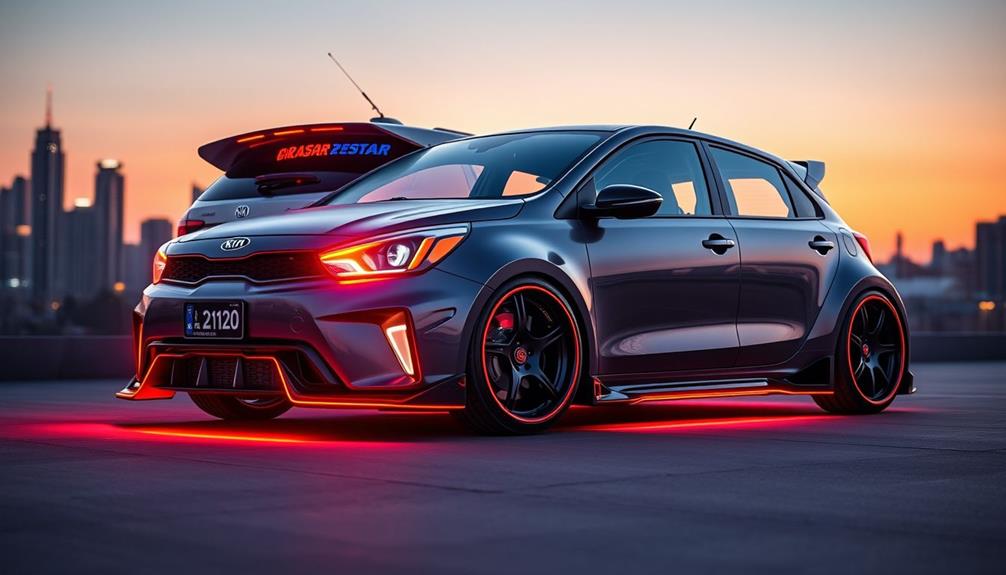
With an eye toward the future, many Kia Rio enthusiasts are exploring exciting performance upgrades, including the possibility of swapping in a 2.0T engine from the Optima. This engine swap could yield a significant horsepower increase, but remember to prioritize financial planning before diving into major modifications.
The community's buzzing about various tuning options like performance chips and ECU tuning, which can boost horsepower and torque by up to 15%. These enhancements optimize the air-to-fuel ratio, pushing your Rio's performance further.
Additionally, enthusiasts are considering turbochargers and aftermarket parts for stroker engines to elevate performance metrics beyond current capabilities. Engaging with the Kia Rio club in Georgia fosters knowledge sharing and collaboration on performance projects, creating a supportive environment for customization.
Here's a quick look at popular performance upgrades:
| Upgrade Type | Expected Benefit |
|---|---|
| Engine Swap | Increased horsepower |
| Performance Chips | Up to 15% power boost |
| ECU Tuning | Optimized fuel efficiency |
| Turbochargers | Enhanced acceleration |
| Aftermarket Parts | Customization options |
These anticipated modifications may surprise fellow car enthusiasts, transforming your compact vehicle into a true sleeper car.
Performance Enhancement Options

Exploring performance enhancement options for your 2013 Kia Rio Hatchback can lead to an exhilarating driving experience.
By focusing on a few key upgrades, you can greatly boost horsepower and torque while improving throttle response. Here are some options to contemplate:
- K&N Short Ram Intake: This upgrade can increase horsepower and torque by up to 10%, enhancing overall engine performance.
- Stage 1 Performance Chip: Release hidden engine potential, boosting horsepower by up to 15% and improving throttle response.
- Custom Exhaust System: Not only does it modify the exhaust sound, but it also improves airflow, potentially increasing wheel horsepower to around 140 with proper tuning.
Additionally, implementing performance spark plugs with a 0.4mm electrode tip enhances combustion efficiency, ensuring your engine runs smoother.
For those seeking a considerable upgrade, contemplate an engine swap to a 2.0T from the Optima, which will greatly heighten your car's power output.
With these performance enhancement options, you can transform your compact car into a thrilling ride that stands out on the road.
Frequently Asked Questions
Can You Modify a Kia Rio?
Yes, you can definitely modify a Kia Rio! Upgrades like performance intakes, spark plugs, and even performance chips can greatly enhance its power. Joining local car clubs can also help you find great modification tips and resources.
What Is the Top Speed of a Kia Rio Hatchback?
Think of your Kia Rio Hatchback as a sprinter—its top speed in stock form hits around 180 km/h. With some upgrades, you could push it closer to 200 km/h, releasing its full potential!
What Is the Eco Mode on a 2013 Kia Rio?
Eco Mode on your 2013 Kia Rio optimizes engine performance and fuel efficiency. It adjusts throttle response and transmission settings, helping you achieve up to 31 mpg in the city and 40 mpg on the highway.
Which Kia Rio Engine Is Best?
The best engine for your Kia Rio is the 1.6L GDI. It offers a solid balance of power and efficiency, making it ideal for daily driving while allowing for potential performance upgrades if you desire more.
Conclusion
In conclusion, tuning your 2013 Kia Rio hatchback can transform your driving experience, much like turning a simple sketch into a vibrant masterpiece. With the right modifications, you'll release impressive performance and enjoy a community that shares your passion. Don't shy away from challenges; they're part of the journey. Embrace the future of performance and make your compact car not just a ride, but a thrilling adventure on wheels.
Ethan is at the forefront of hybrid vehicle technology, making him an invaluable resource for our readers interested in hybrid tuning. His expertise in electric motor upgrades, battery systems, and regenerative braking allows him to provide cutting-edge advice on optimizing hybrid vehicles for performance and efficiency. Ethan’s work ensures that our content stays ahead of the curve in the rapidly evolving world of hybrid technology.
Kia Tuning
Kia Ceed 3 Tuning: Unlocking the Full Potential of Your Compact Hatchback
Kia Ceed 3 tuning unleashes powerful performance enhancements—discover the secrets to maximizing your hatchback’s potential and join the excitement today!

Tuning your Kia Ceed 3 is a game-changer, releasing up to a 31% increase in power while boosting throttle response for a sportier feel. Simple modifications like ECU remapping and air filter upgrades are a great start, leading to improved handling with a suspension drop. You can even enhance your fuel efficiency by cutting consumption by up to 1.5 liters per 100 km. With a 2-year engine warranty and a 50-day trial period, you've got nothing to lose. Ready to discover the best tuning options and join a vibrant community of enthusiasts? There's more valuable information waiting for you.
Key Takeaways
- Tuning your Kia Ceed can boost performance by up to 31%, enhancing your driving experience significantly.
- Stage 1 modifications, including ECU remapping and air filter upgrades, optimize performance without extensive changes.
- Suspension drops of 30-40mm enhance handling and stability, perfect for sportier driving dynamics.
- A 2-year engine warranty ensures peace of mind after tuning, along with a 50-day trial period for testing.
- Access a wealth of resources, including forums and guides, to support your tuning journey and share experiences with the community.
Benefits of Tuning Your Kia Ceed
Tuning your Kia Ceed offers a range of impressive benefits that can greatly enhance your driving experience. By investing in engine tuning, you can enjoy significant performance improvement, with potential power gains of up to 31%. This means not only a boost in engine power but also driving fun that makes every journey exhilarating.
One of the key advantages is improved throttle response, which allows for sportier starts and a more dynamic feel, especially in urban settings. You'll notice that driving modes like Efficiency, Sport, and Race let you customize your experience according to your preferences.
Plus, chip tuning can lead to increased fuel efficiency, with lower fuel consumption reported at up to 1.5 liters less per 100 kilometers. With these enhancements, you'll not only enjoy the thrill of a tuned engine but also the peace of mind that comes from improved fuel savings.
And, thanks to an extensive 2-year engine warranty and a 50-day trial period, you can test these performance enhancements with confidence. So, get ready to access the full potential of your Kia Ceed!
Key Tuning Modifications
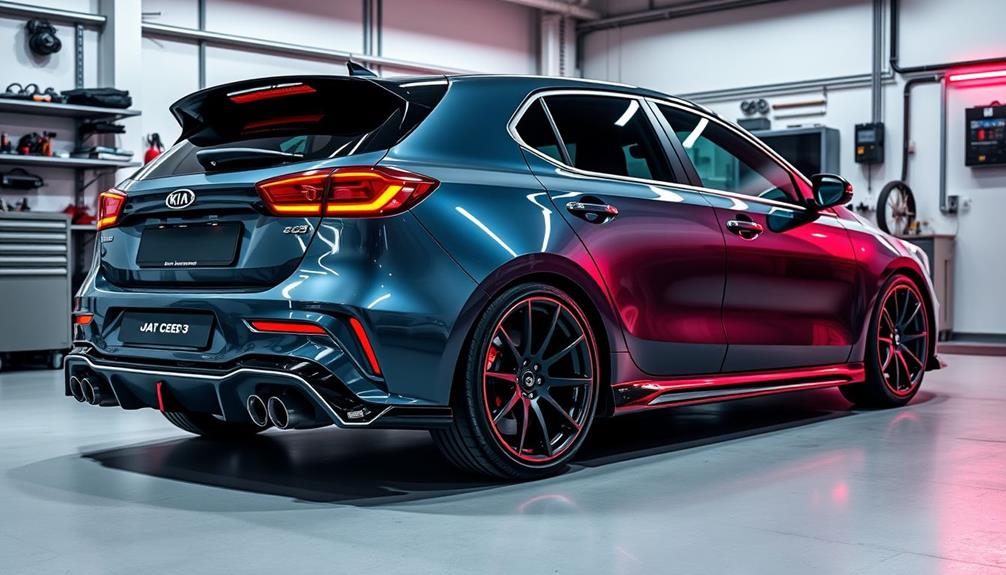
When it comes to modifying your Kia Ceed 3 for better performance, several key tuning modifications can make a significant difference.
These enhancements not only boost your engine's capabilities but also improve driving dynamics, safety, and control. Here are some essential tuning modifications to evaluate:
- Stage 1 Tuning: Upgrading to a panel air filter and remapping the ECU can enhance performance while reducing fuel consumption.
- Suspension Drop: Lowering your suspension by 30-40mm improves handling and stability during different driving conditions.
- Power Clutches: For Stage 2, evaluate power clutches and upgraded fuel injectors to gain substantial horsepower without sacrificing reliability.
- Forced Induction: Stage 3 modifications, like competition cams, maximize your engine's potential with cutting-edge technology.
- Chip Tuning: This can release a significant performance boost, exemplifying how tuning can lead to impressive fuel savings.
Community and Resources for Tuning
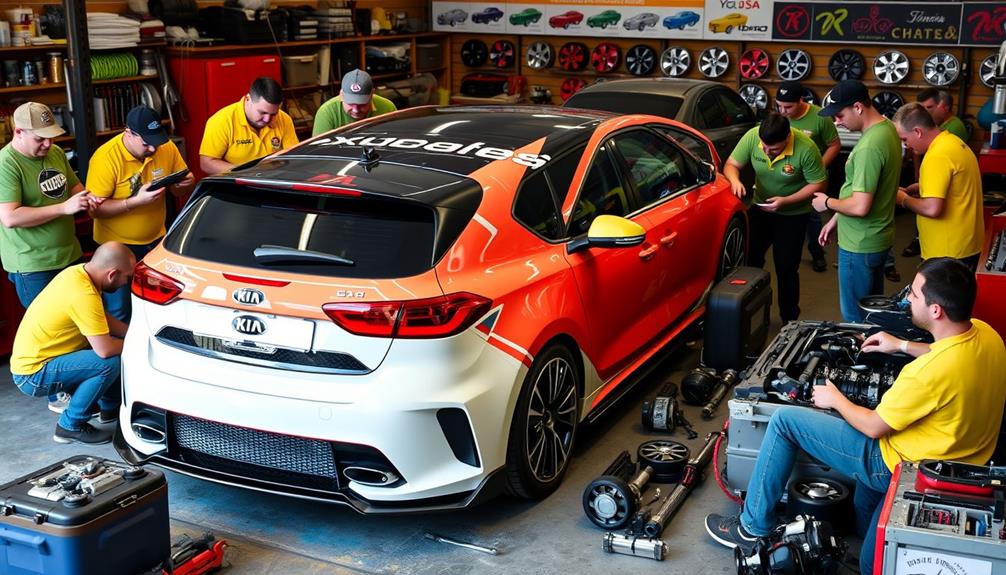
How can you tap into the wealth of knowledge and support available in the Kia tuning community? By engaging with forums and resources, you can enhance your tuning journey. With over 300,000 posts, you'll find valuable tuning tips and project updates shared by fellow enthusiasts.
Additionally, exploring the modified car gallery can inspire your own modifications, showcasing a variety of Kia models that have successfully undergone tuning. If you're looking for detailed instructions, extensive guides specifically targeting your Kia model are readily available. These guides cover everything from ECU remapping to performance upgrades designed to improve your driving experience, especially in city traffic.
For visual learners, the community's YouTube channel offers a treasure trove of content. You can watch practical demonstrations that simplify complex tuning processes. Plus, accessing this content on your Android smartphone makes it even easier to learn on the go.
Here's a quick overview of the resources you can utilize:
| Resource Type | Description | Access Method |
|---|---|---|
| Forums | Discussion and tips from enthusiasts | Online forum |
| Modified Car Gallery | Inspiration from other Kia models | Community website |
| Extensive Guides | Step-by-step tuning instructions | Downloadable PDFs |
| YouTube Channel | Visual tutorials on tuning processes | YouTube platform |
Frequently Asked Questions
Can You Tune a Kia Ceed?
Yes, you can tune a Kia Ceed using methods like chip tuning or engine remapping. These options enhance performance and efficiency, allowing you to tailor your driving experience to match your preferences and needs.
What Is the Top of the Range Kia Ceed?
The top-of-the-range Kia Ceed is the Ceed GT. With its powerful 1.6-liter turbocharged engine and sport-tuned features, it offers an exhilarating driving experience and advanced technology to enhance your journey on the road.
What Is a Kia Ceed?
The Kia Ceed's like a versatile Swiss Army knife for drivers. It's a compact hatchback that blends practicality with performance, offering various engine options, advanced tech, and spacious comfort for your everyday adventures.
What Is the Kia Ceed Level 2?
The Kia Ceed Level 2 offers you enhanced features like a larger touchscreen, advanced safety systems, and sportier aesthetics. You'll enjoy heated seats and improved connectivity, balancing efficiency and power for a dynamic driving experience.
Conclusion
By tuning your Kia Ceed, you're not just enhancing performance; you're starting on a journey akin to Phaethon soaring through the skies. Each modification can reveal your hatchback's hidden potential, transforming it into a true powerhouse on the road. With the right community and resources by your side, you'll find endless possibilities awaiting you. So, embrace the thrill of tuning, and watch as your compact car evolves into something extraordinary, ready to conquer any challenge.
Ethan is at the forefront of hybrid vehicle technology, making him an invaluable resource for our readers interested in hybrid tuning. His expertise in electric motor upgrades, battery systems, and regenerative braking allows him to provide cutting-edge advice on optimizing hybrid vehicles for performance and efficiency. Ethan’s work ensures that our content stays ahead of the curve in the rapidly evolving world of hybrid technology.
-

 Tesla Tuning2 months ago
Tesla Tuning2 months agoTesla Cybertruck Sales: How Many Have Been Sold So Far?
-

 Tesla Tuning2 months ago
Tesla Tuning2 months agoTesla Battery Replacement Costs Revealed: How Much Will You Pay?
-

 Tesla Tuning2 months ago
Tesla Tuning2 months agoSupercharging Tesla: How Long Does It Really Take?
-

 Tesla Tuning2 months ago
Tesla Tuning2 months agoWhere Are Tesla Cars Made? Explore the Manufacturing Locations!
-

 Tesla Tuning3 months ago
Tesla Tuning3 months agoTesla Mileage: How Many Miles Can You Drive on a Full Charge?
-

 Tesla Tuning2 months ago
Tesla Tuning2 months agoHow Much Does It Cost to Lease a Tesla? Get the Full Breakdown!
-

 Tesla Tuning3 months ago
Tesla Tuning3 months agoTesla CarPlay: Does Tesla Have Apple Integration?
-

 BMW Tuning3 months ago
BMW Tuning3 months agoBMW B58 Tuning: Maximize Power in BMW’s Powerful Six-Cylinder Engine


















